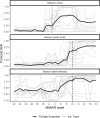Collaborative efforts to forecast seasonal influenza in the United States, 2015-2016
- PMID: 30679458
- PMCID: PMC6346105
- DOI: 10.1038/s41598-018-36361-9
Collaborative efforts to forecast seasonal influenza in the United States, 2015-2016
Abstract
Since 2013, the Centers for Disease Control and Prevention (CDC) has hosted an annual influenza season forecasting challenge. The 2015-2016 challenge consisted of weekly probabilistic forecasts of multiple targets, including fourteen models submitted by eleven teams. Forecast skill was evaluated using a modified logarithmic score. We averaged submitted forecasts into a mean ensemble model and compared them against predictions based on historical trends. Forecast skill was highest for seasonal peak intensity and short-term forecasts, while forecast skill for timing of season onset and peak week was generally low. Higher forecast skill was associated with team participation in previous influenza forecasting challenges and utilization of ensemble forecasting techniques. The mean ensemble consistently performed well and outperformed historical trend predictions. CDC and contributing teams will continue to advance influenza forecasting and work to improve the accuracy and reliability of forecasts to facilitate increased incorporation into public health response efforts.
Conflict of interest statement
J.S. discloses partial ownership of S.K. Analytics, S.K. and H.M. disclose consulting for S.K. Analytics. The remaining authors declare no competing interests.
Figures





References
-
- Centers for Disease Control and Prevention. Estimated Influenza Illnesses and Hospitalizations Averted by Vaccination — United States, 2013–14 Influenza Season, https://www.cdc.gov/flu/about/disease/2014-15.htm (2015).
-
- Centers for Disease Control and Prevention. Overview of Influenza Surveillance in the United States, https://www.cdc.gov/flu/weekly/overview.htm (2016).

